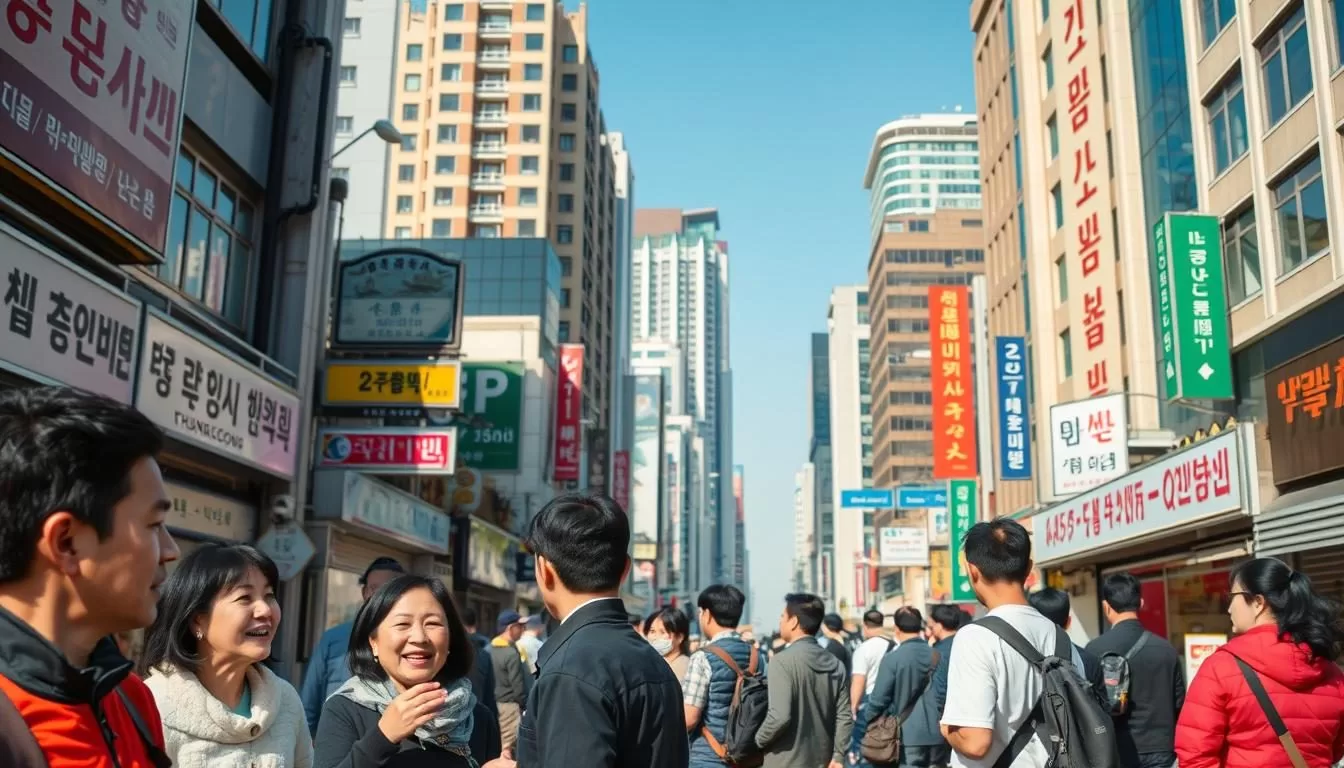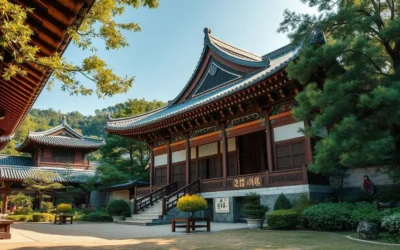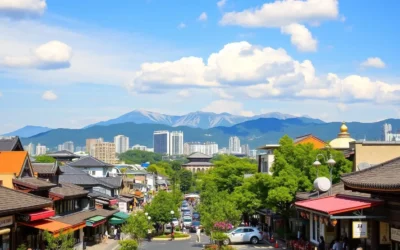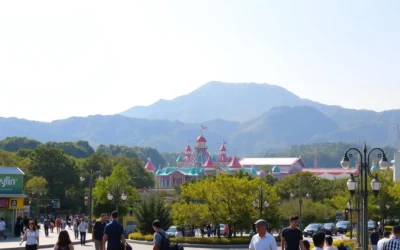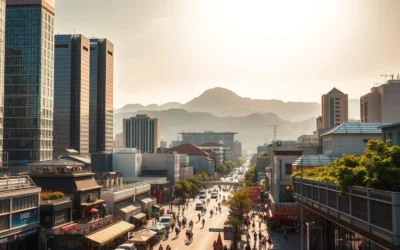✓ Accommodations✓ Flights✓ Rental Cars
You’re about to explore the rich cultural heritage and linguistic diversity of a region in South Korea that boasts a unique dialect and a distinct cultural identity. The Korean language, with its distinctive grammar, vocabulary, and alphabet (Hangul), is the backbone of this region’s linguistic landscape.
As you delve into the world of the Chungcheong dialect, you’ll discover its slower tempo and distinctive pronunciation patterns, which reflect the region’s culture and history. This region’s language has evolved over centuries, influenced by geographical and cultural factors, making it a fascinating subject to explore.
By understanding the language patterns and dialect of this region, you’ll gain valuable insights into the Korean language and its variations, enriching your knowledge of South Korea‘s linguistic diversity.
The Linguistic Landscape of South Korea
South Korea’s linguistic landscape is characterized by its official language and various regional dialects. The country has a rich linguistic heritage, with Korean being the official language spoken by the vast majority of its population.
Korean as the National Language
Korean is the sole official language of South Korea, used throughout the Korean peninsula. It has a unique writing system called Hangul, created by King Sejong in the 15th century as a revolutionary phonetic alphabet to increase literacy among common people. With over 77 million speakers worldwide, Korean is a significant language in global terms.
The Korean language has played a crucial role in shaping the country’s identity and culture. Its unique writing system, Hangul, is considered one of the most scientific and efficient writing systems in the world.
Overview of Regional Dialects
South Korea is home to six main dialects: Seoul & Gyeonggi dialect, Gangwon dialect, Chungcheong dialect, Gyeongsang dialect, Jeolla dialect, and Jeju dialect. Each dialect has its own distinctive features, offering insights into the regional cultures of South Korea. While Standard Korean, based on the Seoul dialect, is used in education, media, and government, regional dialects continue to thrive in everyday conversation.
The linguistic diversity across different regions is a testament to the country’s rich cultural tapestry. High literacy rates and internet penetration have influenced language standardization while allowing regional linguistic diversity to flourish.
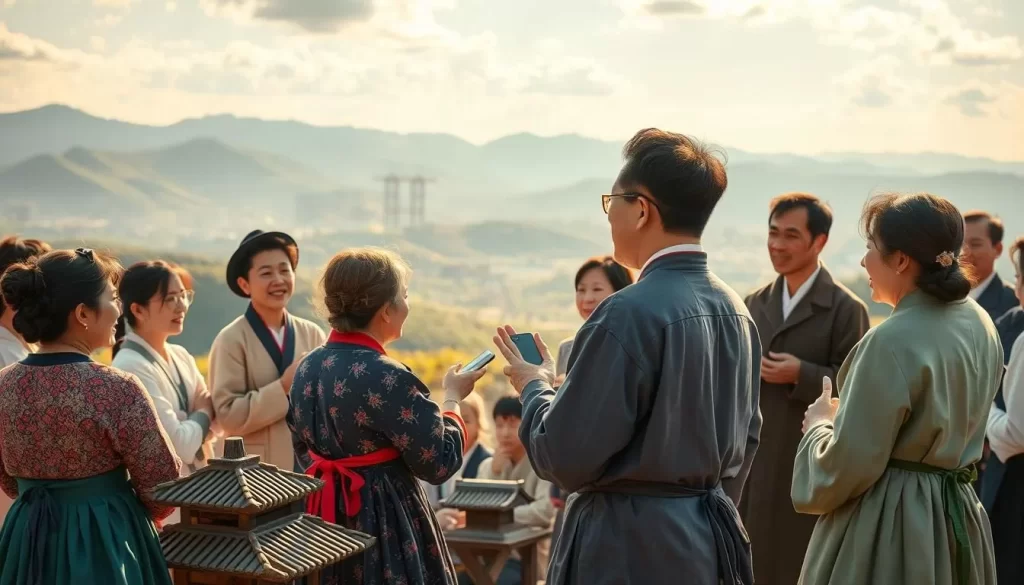
South Chungcheong Province, South Korea: Official and widely spoken languages
In South Chungcheong Province, the official language plays a crucial part in daily life, education, and governance. As the backbone of formal communication, Standard Korean, or Pyojuneo, is used consistently across the region.
Standard Korean (Pyojuneo) in South Chungcheong
Standard Korean is the benchmark for formal communication in South Korea, ensuring consistency across the nation. It is used in schools, government offices, and media. The Gyeonggi dialect forms the basis of Pyojuneo, with about 70% of its vocabulary adopted as the standard. You will find that in Chungcheong Province, including cities like Daejeon and Sejong, young people are increasingly using standard language and dialect alternately. 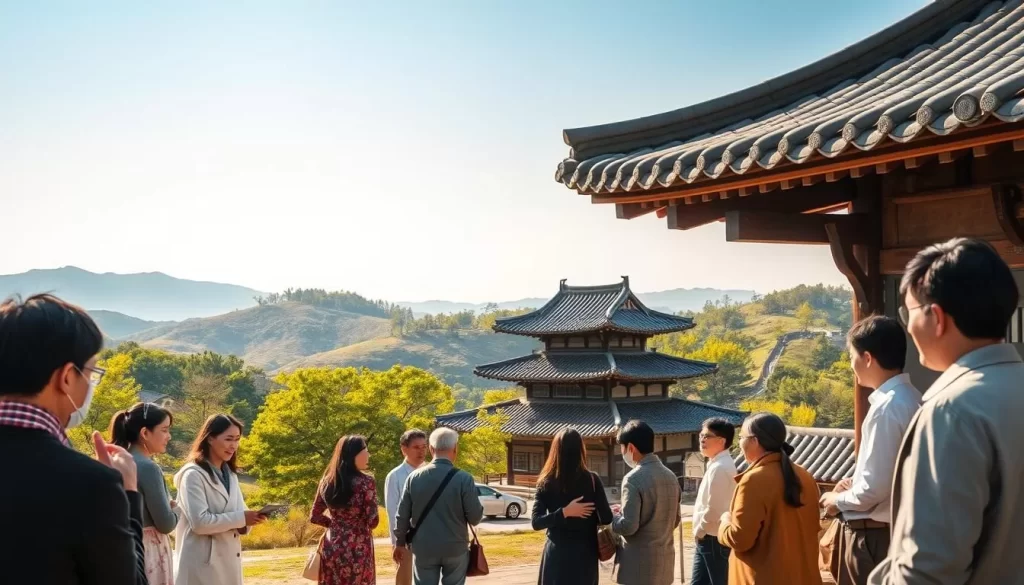
This blend of languages reflects the dynamic nature of language use in the region. As you explore further, you’ll notice that the use of Standard Korean is particularly prevalent in formal settings and official contexts.
Language Demographics and Usage Patterns
The demographics of language use in South Chungcheong Province reveal interesting patterns. Age, education, and urban/rural divides significantly affect dialect usage. For instance, in cities like Cheonan, which are located near the Seoul metropolitan area, the local dialect is on the verge of extinction among younger generations, who predominantly use Standard Korean. Media consumption, education policies, and social mobility have also influenced language patterns, creating a complex linguistic landscape.
As you delve deeper, you’ll discover that the relationship between Standard Korean and the local Chungcheong dialect is multifaceted. While Standard Korean is used in formal contexts, the dialect is often used in informal settings, showcasing a nuanced coexistence of languages within the region.
The Chungcheong Dialect: A Linguistic Identity
You’ll find that the Chungcheong dialect is a distinctive and integral part of the language heritage in South Chungcheong Province. This dialect is not just a means of communication; it’s a reflection of the region’s history, culture, and daily life. As you delve into the characteristics of the Chungcheong dialect, you’ll discover what makes it unique and how it contributes to the region’s identity.
Distinctive Pronunciation Features
The Chungcheong dialect is known for its slower tempo, giving it a relaxed, laid-back manner of speaking. One of its distinctive pronunciation features is the vowel shift during verb conjugation. For example, ㅗ (o) changes to ㅜ (oo), and ㅛ (yo) changes to ㅠ (yu). This is evident when the standard verb ending -요 (yo) in “가요” (gayo, go) shifts to -유 (yu), resulting in “가유” (gayu). Such pronunciation characteristics make the Chungcheong dialect immediately recognizable.

Unique Grammatical Structures
The Chungcheong dialect also exhibits unique grammatical structures that differentiate it from Standard Korean. A notable example is the question-ending pattern “-n gyeo” (-ㄴ 겨), which is used in place of standard Korean forms like (-니), (-어), and (-ㄴ 거야). For instance, when asked questions, speakers of the Chungcheong dialect tend to use “-n gyeo” (-ㄴ 겨), giving their language a distinct grammatical structure.
Vocabulary and Expressions Specific to South Chungcheong
The vocabulary and expressions used in the Chungcheong dialect are specialized and reflect the local culture, history, and daily life of South Chungcheong Province. These unique words and phrases not only add flavor to the dialect but also provide insights into the region’s heritage. By learning these expressions, you’ll gain a deeper understanding of the local culture and be able to appreciate the dialect’s significance.
Some key aspects of the Chungcheong dialect include:
- Characteristic vowel shifts, such as ㅛ (yo) changing to ㅠ (yu), which are a hallmark of the dialect.
- Unique grammatical structures, like the question-ending pattern “-n gyeo” (-ㄴ 겨), that replace standard Korean forms.
- Specialized vocabulary and expressions that reflect the local culture and daily life.
- Practical examples that illustrate how standard Korean phrases transform in the Chungcheong dialect.
- A slower tempo and relaxed intonation that contribute to the stereotype of the region’s people being laid-back and unhurried.
By understanding these features, you’ll be able to recognize and appreciate the Chungcheong dialect’s contribution to the rich linguistic diversity of South Korea.
Historical Development of Language in South Chungcheong
As you explore the linguistic heritage of South Chungcheong Province, you’ll uncover a rich history that spans over two millennia. The Korean language has evolved significantly, influenced by various historical events and geographical factors.
Origins of the Chungcheong Dialect
The Chungcheong dialect has its roots in the ancient languages spoken on the Korean Peninsula. Initially, Chinese characters were used for writing, a practice that continued for centuries. The introduction of Hangul by King Sejong in the 15th century revolutionized writing, making it accessible to the masses. This phonetic alphabet, known as Hunminjeongeum, consisted of 24 letters and was easy to learn, marking a significant turning point in Korean linguistic history.
- The geographical isolation of South Chungcheong Province contributed to the development of distinct dialect features.
- Historical events, including invasions and political changes, shaped the evolution of the language in the region.
Evolution Through the Centuries
Over the centuries, the Chungcheong dialect has evolved through various historical periods, from the Three Kingdoms period to the Goryeo and Joseon dynasties, and into the modern era. Each era brought changes in language use, reflecting the social and cultural contexts of the time. The transition from Chinese characters to Hangul had a lasting impact on the region’s linguistic landscape.

The dialect’s unique characteristics have been preserved due to the region’s relative isolation. Understanding this evolution provides valuable insights into the cultural heritage of South Chungcheong Province.
Geographical Subdivisions and Dialect Variations
As you explore South Chungcheong Province, you’ll notice the diverse linguistic landscape shaped by geographical subdivisions. The province is characterized by a rich tapestry of dialects that vary significantly across different regions.
Northern and Southern Chungcheong Dialect Differences
The Chungcheong dialects can be broadly categorized into Northern and Southern dialects, each with distinct features. The Northern Chungcheong dialect shows a significant influence from the Gyeonggi dialect, whereas the Southern dialect shares many characteristics with the Jeolla dialect. This divergence is largely due to historical and geographical factors.
- The Northern part, including cities like Cheongju and Chungju, exhibits linguistic features similar to those found in the Gyeonggi region.
- In contrast, the Southern part, encompassing Daejeon, Sejong, and Cheonan, displays dialectical traits akin to the Jeolla dialect.
Urban vs. Rural Language Patterns
The language patterns in South Chungcheong Province also vary significantly between urban and rural areas. Urban centers like Daejeon and Sejong have been influenced by standard Korean, making their dialects somewhat different from those in rural areas.
In contrast, rural communities tend to preserve more traditional dialect features, creating a linguistic continuum from urban centers to countryside villages. Geographical features such as mountains and rivers have also played a role in shaping these dialects.
Cultural Influences on Language in South Chungcheong
As you explore the linguistic landscape of South Chungcheong, you’ll discover how deeply culture influences the way people communicate. The region’s language is a vibrant reflection of its heritage, shaped by both traditional customs and modern trends.
Traditional Customs and Their Linguistic Expressions
Traditional customs in South Chungcheong have significantly contributed to the unique linguistic expressions found in the local dialect. For instance, major holidays like Lunar New Year and Chuseok have embedded specific phrases and idioms into everyday speech. The region’s agricultural traditions and historical industries have also given rise to specialized terminology that reflects the local cultural heritage. You can observe how these customs have influenced the dialect by looking at the words and phrases used during seasonal festivals.
Modern Media and Entertainment Impact
The rise of K-pop and Korean dramas has had a profound impact on the language patterns in South Chungcheong, especially among younger speakers. Modern media has introduced new terms and expressions, some of which have become integral to the local dialect. You might notice how television, radio, and internet content have influenced the preservation or erosion of the Chungcheong dialect among different age groups. The global popularity of Korean entertainment has not only shaped language but also reinforced cultural stereotypes about Chungcheong people being relaxed and traditional.
| Cultural Influence | Impact on Language |
|---|---|
| Traditional Customs | Unique linguistic expressions and vocabulary |
| Modern Media | Introduction of new terms and expressions |
| Seasonal Festivals | Specialized terminology reflecting local heritage |
You can see that the cultural influences on language in South Chungcheong are multifaceted, ranging from traditional practices to modern media. This blend has created a distinct linguistic identity that is both a source of pride and a subject of interest for linguists and cultural enthusiasts alike.
Comparing Chungcheong Dialect with Other Korean Dialects
The Chungcheong dialect occupies a unique position among Korean dialects, and examining its similarities and differences with other dialects can enhance your understanding of Korean linguistic culture. As you delve into the comparisons, you’ll discover how this dialect relates to others in the region.
Similarities and Differences with Seoul Standard Korean
The Chungcheong dialect shares many similarities with Seoul Standard Korean, given the latter’s role as the national standard. However, distinct differences exist, particularly in pronunciation and certain vocabulary choices. For instance, the Chungcheong dialect retains older pronunciation features that have been lost in Standard Korean. You might notice variations in intonation and accent that are characteristic of the region.
Relationship to Neighboring Jeolla and Gyeongsang Dialects
Geographically, the Chungcheong dialect is situated between the Jeolla and Gyeongsang dialects, and this proximity has influenced its development. While it shares certain features with these neighboring dialects, such as similar grammatical structures, it also maintains its unique characteristics. For example, the Chungcheong dialect has adopted some vocabulary from Jeolla, reflecting historical cultural exchanges.
Mutual Intelligibility Among Korean Dialects
Generally, Korean dialects are mutually intelligible to a significant extent, thanks to the education system’s emphasis on Standard Korean and the pervasive influence of mass media. However, the Jeju dialect stands out as an exception due to its substantial linguistic differences. Speakers of the Chungcheong dialect can usually understand other dialects, including Jeolla and Gyeongsang, although some words or expressions might be unfamiliar.
Key aspects to consider include the historical development of these dialects and their geographical distribution. By understanding these factors, you can better appreciate the complex linguistic landscape of South Korea.
Language Preservation and Education Efforts
The preservation of the Chungcheong dialect is a multifaceted endeavor involving government initiatives and community engagement. As part of South Korea’s cultural heritage, efforts are being made to document, teach, and revitalize this unique aspect of regional identity.
Government Initiatives for Dialect Preservation
The National Institute of Korean Language plays a crucial role in shaping language policies, including the preservation of regional dialects like Chungcheong. Government initiatives include documentation projects and linguistic research aimed at safeguarding the dialect’s unique features. By maintaining a Standard Lexicon with over 1.1 million entries, the institute ensures consistency across education and media.
Educational Programs and Cultural Activities
Educational programs in South Chungcheong Province strive to balance the teaching of Standard Korean with the promotion of local dialect features.
- Cultural activities and festivals celebrate the Chungcheong dialect, engaging residents of all ages.
- Local universities and cultural centers collaborate to document and teach the dialect.
- Community programs work to revitalize the dialect among younger generations.
By working together, these initiatives help gain a deeper appreciation for the Chungcheong dialect as an integral part of Korean language culture. As a result, you can explore the rich heritage and unique characteristics of the Chungcheong dialect through various educational and cultural channels.
Conclusion
Understanding the dialects and languages of South Chungcheong Province offers a unique glimpse into the region’s history and culture. You’ve gained a comprehensive understanding of the official and widely spoken languages in this region, from Standard Korean to the distinctive local dialect. The complex interplay between standardization efforts and dialect preservation contributes to South Korea’s rich linguistic landscape. This understanding will enhance your connection to the people and traditions of South Chungcheong Province, allowing you to gain deeper appreciation for its heritage.
The above is subject to change.
Check back often to TRAVEL.COM for the latest travel tips and deals.
